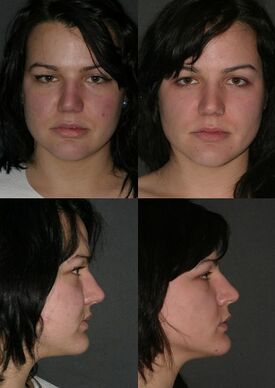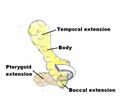Medicine:Buccal fat extraction
Buccal fat pad extraction is a plastic surgery procedure for reducing prominent cheeks, by the proportional removal of buccal fat-pad tissue.
Surgical procedure
The reduction of buccal fat pads usually is performed upon a patient either under conscious sedation or under general anaesthesia. The typical approach for removing the buccal fat pad is through an incision in the mouth, towards the back of the buccal cavity, near the second upper molar; and another incision is made through the buccinator muscle, which incisions produce an opening for access to the buccal fat pads. Afterwards, the surgeon applies manual pressure to the exterior of the cheek, which pushes the buccal fat pad to protrude to the interior of the mouth, which permits gripping the pad with forceps. Once extracted from its place, the surgeon then resects (cuts and removes) the required amount of tissue from the buccal fat pad to achieve the desired cheek reduction; the remainder of the buccal fat pad then is replaced to its anatomic site, and the two incisions are sutured.
Injury to the buccal branch of the facial nerve is a risk; the buccal branch nerves that might be affected control facial functions, therefore, such damage might result in partial facial paralysis, regional facial numbness, loss of taste, et cetera. Likewise, damage to the parotid duct also might occur in men and women whose parotid ducts run deep to the buccal fat pad, which can lead to hematoma, and might affect salivation.[1]
- Extracted buccal fat.JPG
Cheek reduction: The buccal fat pads extracted from a patient who underwent bilateral cheek reduction
References
- ↑ "Interrelated Buccal Fat pad with Facial Buccal Branches and the Parotid Duct", Journal of Craniofacial Surgery 16 (4): 658–660, July 2005, http://www.biomedexperts.com/Abstract.bme/16077311/Interrelated_buccal_fat_pad_with_facial_buccal_branches_and_parotid_duct




